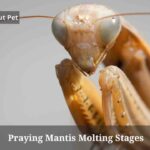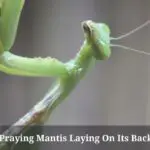If you own or you are considering adopting a praying mantis as a pet, you may have an interest in knowing how often praying mantises usually molt. There are also those who may want to know how often praying mantis molt out of pure curiosity. Read on, to find out.
How often do praying mantis molt? That can typically range from once every 9 days to once every 15 days. But molting frequency varies from one praying mantis to another, with older ones molting much less frequently.
Sometimes, you may find that your praying mantis hasn’t molted in well over a month. So in that case, your worry would be as to whether a praying mantis going so long without molting is normal.
In another case, you may find your praying mantis seeming to be molting almost every week. And in this case, your worry becomes whether such frequent molting is normal in a praying mantis.
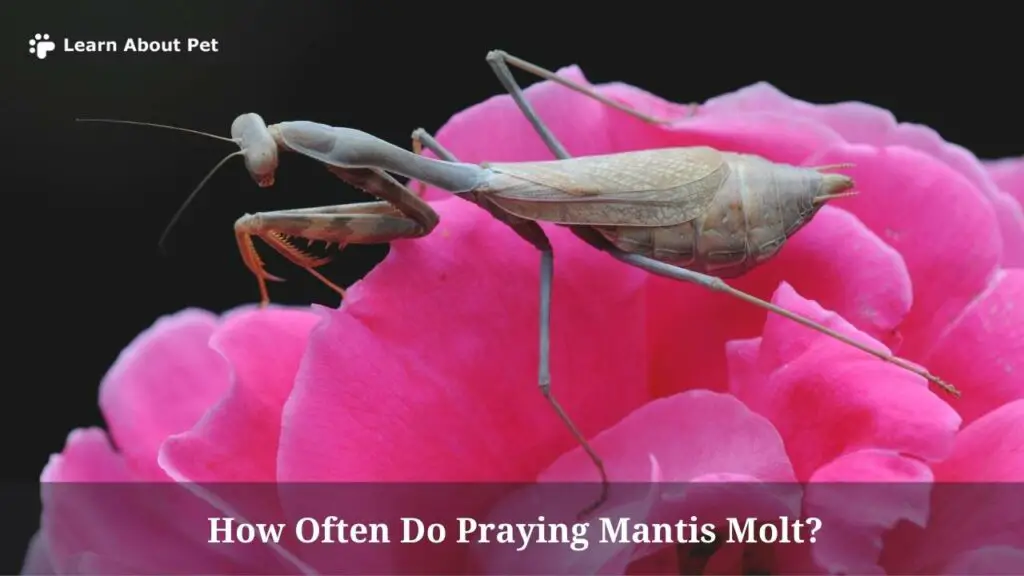
The truth of the matter though is that there is lots of variance in praying mantis molting behaviors.
Asking how often praying mantis molt is akin to, say, asking how often do praying mantis eat? So you find a lot of variance: as some obviously do it more often than others.
Nonetheless, these questions about praying mantis molting are very common. Others in that series would include the likes of do mantis eat their molt, can a praying mantis molt on the ground and so on.
Our focus though is specifically on the one about how often praying mantis molt.
But first, we need to know how exactly praying mantis molt – before proceeding to learn how often they do it.
How Do Praying Mantis Molt?
In the simplest terms, we can describe molting in praying mantis as the process through which they ‘shed their skin’.
When a praying mantis molts, it sheds what is referred to as exuvia. It also gets to replace the old exoskeleton with a new one.
A new exoskeleton will have been growing underneath the old one for a while. Then at molting time, the mantis moves out of the old exoskeleton, exposing the new one…
So in a nutshell, that is what the praying mantis molting process is all about.
With regard to it, you often find someone asking, how can I tell if my praying mantis is molting? Or generally, how do you know when a praying mantis is molting?
This is the answer: normally, when a praying mantis is molting, it will stop eating. Usually, it stops eating for at least a day.
Then the molting praying mantis lies in a prone (upside down) position…
Admittedly, a praying mantis that is molting can look as if it is dying. That is indeed why so many people express interest in knowing praying mantis molting or dying distinction.
Witnessing the praying mantis first molt can be especially frightening, for someone who has never encountered the phenomenon before.
You often find the praying mantis owner asking questions like, will the molting praying mantis be alright? And should I help my praying mantis molt.
So the process is quite intricate and challenging for the mantis.
How Long Do Praying Mantis Molt?
So far, we have described how the praying mantis molting process goes. The question that arises from that is, how long does a praying mantis molt? Or, to be more precise, how long does the praying mantis molting process last?
The answer is that the process of the praying mantis walking out of the old exoskeleton is quite fast. It normally happens within a span of about 20 minutes on average.
However, the praying mantis that is to molt will start lying upside down and refusing to eat one day prior. And even after molting, the praying mantis may require one more day, to go back to being its usual self.
Praying mantis molt pretty much their entire lifespans which can range from 2 months to 8 months.
Within those lifespans, the praying mantis may molt as few as 5 times and as many as 10 times, before dying.
As for the praying mantis first molt, this is typically within a couple of weeks from hatching. But sometimes it delays a bit – to the point of getting the pet mantis owner wondering, why hasn’t my mantis molted yet?
So with regard to things like molting, you really find that different praying mantises go at different paces.
The whole thing is akin to asking, how long do mantis live after they get their wings? And you find that the variance is so huge that you can’t give a single answer. The best you can give is a range.
How Often Do Praying Mantis Molt?
The frequency of praying mantis molting varies from species to species. It also varies from one individual praying mantis to another, even within one species.
Generally though, the praying mantises that molt most often do it like every 9 days. And those that do it most infrequently molt like every 15 days.
Much also depends on the age of the praying mantis: with younger ones tending to molt more often than older ones.
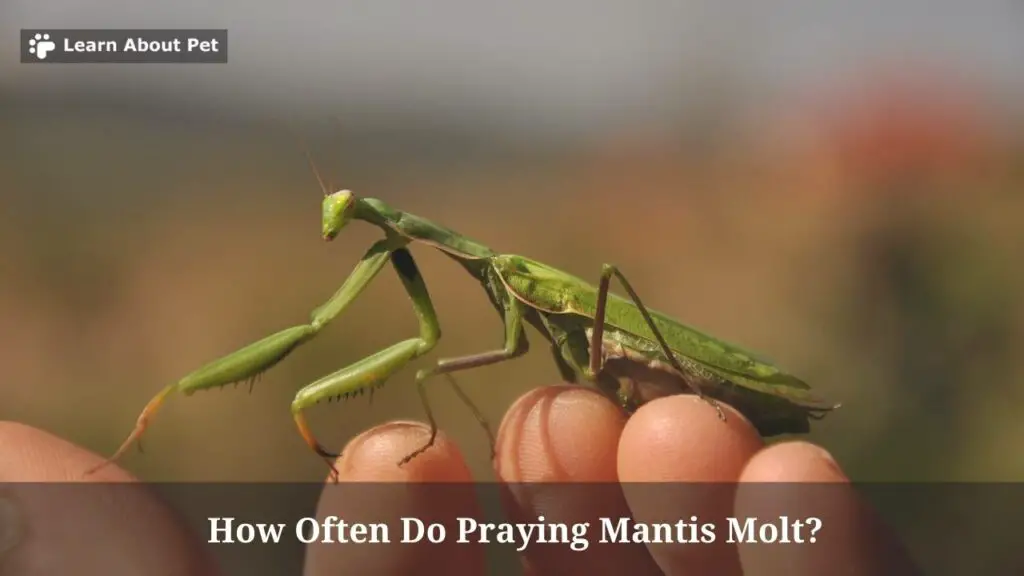
How Often Do Baby Praying Mantis Molt?
Earlier we said that praying mantis usually shed more often when they are younger. In other words, baby praying mantises tend to molt more often than older ones.
This leads to a question: how often do praying mantis molt while in the baby/nymph stage?
It is not uncommon to find baby praying mantis molting every 9 days on average.
After a baby mantis hatches, it will normally go for 2 weeks before the first molt. Thereafter, it starts molting every 9 days or so. But some go for longer – as much as 2 weeks – between molts.
It is important to appreciate that the molting in question here is part of praying mantis growth and development. Younger praying mantis register faster growth rates. That is also why they molt more often.
How Often Do Adult Praying Mantis Molt?
Adult praying mantises tend to molt less frequently than younger ones.
The more precise question is on how often do praying mantis molt once they become adults?
It is not uncommon for an adult praying mantis to go for as many as 15 days (even more) without molting.
Molting, as we said, is part of praying mantis growth and development. And adult praying mantis typically register lower rates of growth than baby mantis. They therefore also molt less often.
How Often Do Orchid Mantis Molt?
Many of the praying mantis that people keep as pets belong to the ‘orchid’ species.
So, how often do orchid mantis molt? It turns out that orchid mantis are among those that molt more often. So about every 10 or so days, an orchid mantis may molt.
How Often Do Spiny Flower Mantis Molt?
The Spiny Flower mantis seem to be among those that molt less often.
While young, their molting frequency may be every 2 weeks. But as they get older, that can turn out to be every 3 or even every 4 weeks.
How Often Do Ghost Mantis Molt?
Ghost mantis tend to take relatively long periods of time between molts.
In their youth, Ghost mantis will often molt every 3 to 5 weeks. But in their older age, their molting frequency goes down – to a point where the period between the second last and the last molt is sometimes 2 months.
What Determines How Often Praying Mantis Molt?
There are three factors that determine how often praying mantis molt.
The first factor that determines praying mantis molting frequency is the species. All other factors held constant, some species of praying mantis molt more frequently than others.
The shorter-lived praying mantis species seem to be the ones that shed more frequently.
The second factor that determines praying mantis molting frequency is age. Thus how often your mantis molt depends greatly on their age.
Younger praying mantises, as we said, tend to molt more frequently than older ones. If you have a younger praying mantis, it is reasonable to expect it to be shedding more frequently.
And if you have an older praying mantis, it is reasonable to expect it to be shedding less frequently.
The challenge that may arise is on how to tell if your mantis is ‘young’ or ‘old’. To that end, you have to know its species. Then know how long that species lives.
Considering your mantis’ age against that will give you an indication on whether it is ‘young’ or ‘old’.
The third factor that may determine praying mantis molting frequency is the condition the mantis is living under. A mantis living under improper conditions may not register satisfactory growth.
And a praying mantis that is not registering proper growth and development will tend to shed less often.
Can You Make Your Praying Mantis Molt More Often?
There may not be much you can do, in the context of how to help a praying mantis molt more often.
If it was a question on something like, say, what to do if your mantis falls while molting, it would be easier to address.
But making a praying mantis molt more often? Why would you even want a praying mantis to molt more often? Isn’t molting a very taxing process on the praying mantis’ body – one that sometimes kills weaker mantises?
So why would anyone want to make a praying mantis molt more often?
The best you can do is provide the praying mantis with optimal living conditions. This way, it will register optimal growth and development. Then it will be molting as often as it should.
During the actual molting process, you can provide adequate humidity to ease it up.
Final Verdict – How Often Do Praying Mantis Molt
Praying mantis molting frequency normally ranges from every 9 days to every 15 days.
How often praying mantises actually molt seems to depend on their species and their age.
Some praying mantis species have a tendency to molt more often than others.
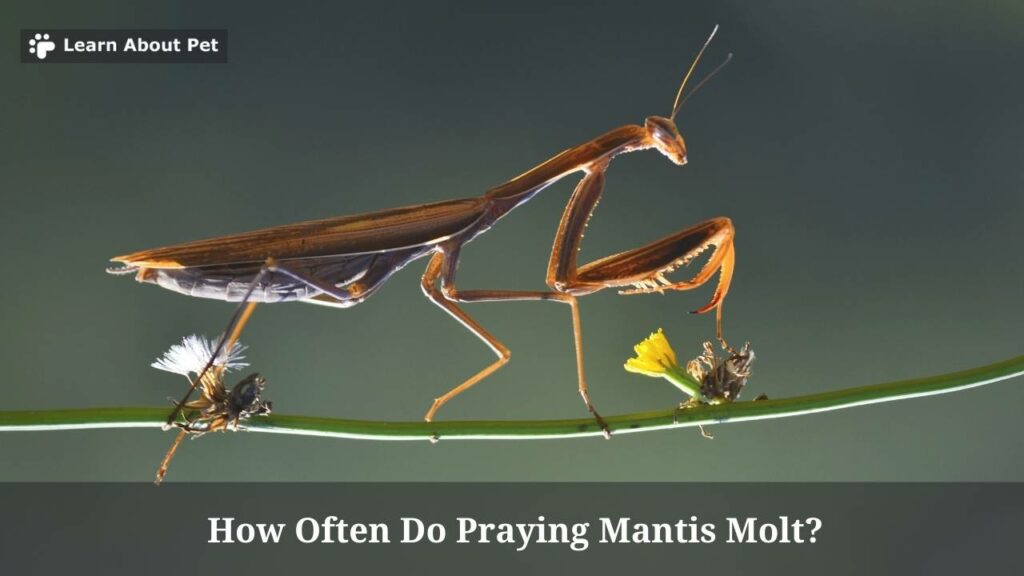
Regarding age, younger praying mantises tend to molt more frequently than older ones. In fact, the oldest mantises may go for longer than even 15 days (actually for as many as 4 weeks) between molts.
Providing a praying mantis with optimal living conditions will ensure that it registers satisfactory growth and development rates. That can in turn help the mantis to molt as often as it ought to be doing, considering its species and age.
As a pet lover, make sure to learn about pet more and give your praying mantis a good and comfortable life!

Welcome to Learn About Pet. My name is Rajkumar Ravichandran and I love all pets, travel, and amazing food. I write about my passion and personal experience caring for multiple pets in this blog! ❤️
Post Disclaimer
DISCLAIMER: THIS BLOG OR WEBSITE, "Learn About Pet", DOES NOT PROVIDE YOU WITH MEDICAL ADVICE AND IS NOT A SUBSTITUTE FOR MEDICAL ADVICE. ALWAYS GET IN TOUCH WITH YOUR PERSONAL VETERINARIAN AND USE INFORMATION HERE AS GENERAL ADVICE.
The information, including but not limited to, text, graphics, images and other material contained on this website are for informational purposes only. No material on this site is intended to be a substitute for professional veterinary advice, food recommendation, diagnosis, or treatment. Always seek the advice of your veterinarian or other qualified health care provider with any questions you may have regarding a medical condition or for pet food related questions.



